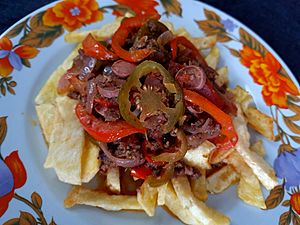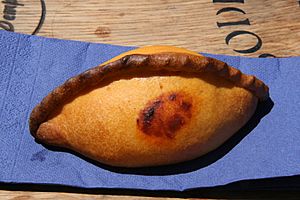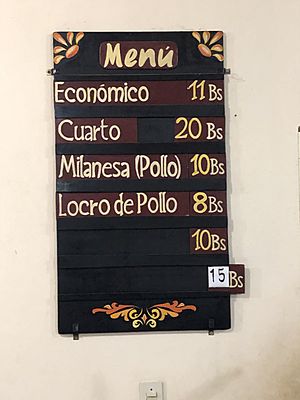Bolivian cuisine facts for kids
Bolivian cuisine is a mix of different cultures. It combines traditional foods from native groups like the Aymara with flavors brought by the Spanish. Over time, influences from German, Italian, French, and Arab immigrants also added to the unique taste.
The main foods in Bolivia are corn, potatoes, quinoa, and beans. When the Spanish arrived, they brought new ingredients. These included rice, wheat, and meats like beef, pork, and chicken. These new foods blended with the traditional ones to create Bolivian dishes.
Bolivian food also changes depending on where you are in the country. In the high, cold Altiplano (western Bolivia), dishes often use many spices. In the warmer lowlands, closer to the Amazon, you'll find more fruits, vegetables, fish, and yuca.
Contents
What Influences Bolivian Food?
Bolivian food has been shaped by many cultures. The ancient Inca cuisine and Aymara cuisine played a big role. The biggest influence, however, comes from Spanish cuisine.
Even though some people from Germany, Italy, and the Basque region moved to Bolivia, their food influences are smaller. Spanish cooking traditions remain the most important part of Bolivian cuisine.
Popular Bolivian Dishes
Bolivia has many tasty dishes, sauces, and drinks. Here are some popular ones:
Main Dishes to Try
- Arroz con queso: This means "rice with cheese."
- Charque: Dried meat, often from llama or beef.
- Ají of noodles: Noodles served with a spicy pepper sauce.
- Saice: A stew with meat, potatoes, and vegetables.
- Fricasé: A hearty pork stew, often eaten for breakfast.
- Pique macho: A large plate with pieces of beef, sausages, onions, peppers, and fries. It's topped with a special sauce.
- Salteñas: These are like baked empanadas, filled with juicy meat or chicken, vegetables, and sometimes a piece of egg.
- Sopa de maní: A delicious peanut soup.
- Silpancho: A large, thin piece of breaded meat served with rice, potatoes, and a fried egg.
Flavorful Bolivian Sauces
- Ají: A general term for spicy sauces made from chili peppers.
- Llajwa: A popular spicy sauce made from locoto peppers and tomatoes. It's often served with almost every meal.
Traditional Bolivian Drinks
- Singani: A clear grape brandy, often used in cocktails.
- Yungueño: A refreshing drink, often made with fruit.
- Mocochinchi: A sweet, non-alcoholic drink made from dried peaches.
Sweet Treats in Bolivia
Bolivian sweets often use natural sweeteners like honey and sugarcane. Manjar blanco is a creamy sweet spread, similar to dulce de leche. It's used as a filling for desserts like alfajores, which are sweet cookies.
Many sweet fruits are used in desserts. These include bananas, guava, coconut, passion fruit, and raisins. Coconut is very popular and found in many sweets. Examples are cocadas (coconut candies), coconut pudding, and pastelitos (small pastries).
Some local fruits come from the Amazon rainforest, like the achacha. Other fruits are native to the Andes mountains. The cherimoya fruit, also called "custard apple," is from the Andes. It's often used to make ice cream and other sweets. The writer Mark Twain once called the cherimoya "the most delicious fruit known to men."
Helado de canela is a type of sorbet flavored with cinnamon. Tawa-Tawas are fried pastries sweetened with miel de caña (sugarcane syrup).
Buñuelos are sweet fried fritters. People often eat them for breakfast with a sweet drink called api. Api is made from morocho corn, cinnamon, milk, and sugar. Another breakfast food is the Andean fruit tamarillo. It's often used to make compotes, marmalades, and other desserts.
Bolivian Meal Times
Bolivians have a specific structure for their daily meals.
Breakfast (desayuno)
Breakfast can be simple or very filling. Most Bolivians start their day with a black coffee, called cafe tinto, and a piece of bread. Some might have a more elaborate meal with pastries or fritters.
Lunch (almuerzo)
Lunch, or almuerzo, is the most important meal of the day in Bolivia. Daily life often stops for it. Many businesses and shops close between 12 PM and 2 PM. This allows workers to go home and enjoy lunch with their families.
A typical Bolivian lunch has several courses. It usually starts with a soup. Then comes a main dish with meat, rice, and potatoes. After that, there might be a dessert and coffee. Lunch is a relaxed meal, and it's often followed by a short nap, known as a siesta.
Afternoon Tea (té)
Bolivians enjoy an afternoon tea break, similar to the tradition in England. These tea breaks usually happen around 4 PM or 5 PM at salones de té (tearooms). These tearooms often also sell baked goods. So, people enjoy tea with pastries or biscuits like galletas Maria. Sometimes, traditional humintas (corn cakes) are served. Instead of black tea, Bolivians often drink coca or herbal teas.
Dinner (cena)
Dinner is usually lighter and more casual than lunch. It typically takes place later in the evening, often at 8 PM or even later.
See also
 In Spanish: Gastronomía de Bolivia para niños
In Spanish: Gastronomía de Bolivia para niños




